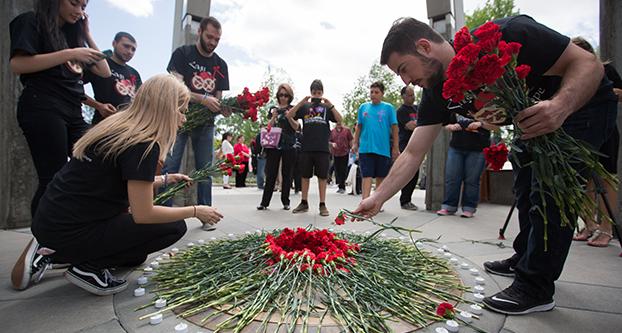The loss of life on a grand scale seems like an unforgettable occurrence, yet humans throughout history have allowed massacres of cultures and races.
This fact brought an element of solemnity and poignancy to the Armenian Genocide Commemoration hosted Friday by the Armenian Studies Program and Armenian Student Organization (ASO) at Fresno State’s Armenian Genocide Monument for the 101st anniversary of the atrocity.
Information Sciences student Sean Minier attended the event to honor of his great-grandparents who lost their lives to the genocide.
“I want to come here every year and bring a flower for them — it’s a chance to pay my respects,” Minier said. “It adds to the memory of not only my grandparents, but everyone who lost their lives.”
Minier said he feels events recognizing the Armenian Genocide are important so the younger generations and people outside of the culture can learn the history of what happened.
“A lot of people see Armenians as hard workers,” Minier said. “I think that’s because we are trying to rebuild. So much of our heritage was lost, there’s still refugees, and there is still so much to be done.”
The Armenian Genocide is marked annually on April 24 to memorialize the day the genocide began in 1915. The genocide was carried out through death marches, massacres and sexual assaults. As a result 1.5 million Armenian lives were lost.
The commemoration included the performance of songs written about the genocide and the recounting of survivor’s stories by their ancestors. Members of the Armenian Student Organization Hourig Attarian and Diana Gasparyan read memoirs written by their great-grandparents.
Attarian read stories about the loss of an entire extension of her great grandfather’s family due to exposure and a severe lice infestation. She talked about a relative’s baby crying of thirst until perishing in its helpless mother’s arms.
Gasparyan recounted similar tragedies. Her great-grandfather was nine when the genocide began.
He witnessed the execution of the elderly who could not keep up and the disappearance of his older brothers and the forced marriage of her great aunt to a Turkish neighbor. She said the memories were so painful, her grandfather could not help but cry every time they came up.
“The denial of this massacre is a shame humanity will endure forever,” Gasparyan said.
Chair of the Department of Sociology Dr. Matthew Jendian delivered a keynote addressing the need to recall these tragedies.
“‘The cure for the pain is in the pain,’” Jendian said quoting Persian poet and theologian Rumi. “We have to connect this pain to the injustices around the world today.”
Jendian touched on the continued inaction of people to stop ongoing crimes like the genocide in Darfur.
“We hear ‘never again’ all the time but it is only an aspirational hope that people will take actions to prevent crimes against humanity,” Jendian said. “There is no lack of knowledge or influence — it is a lack of will.”
President of the Armenian Student Association Tadeh Issakhanian brought the event near to an end with a call to action. He reminded younger generations of their responsibility to continue the success of generations before them.
“Recognition of the genocide locally is the result of individual action — we need leaders to take their place in the future,” Issakhanian said. “The escalation of advocacy during this week cannot end when April is over.”
The crowd sang the Armenian National Anthem at the close of Issakhanian’s speech. Then while a single flute played people followed in a solemn procession through the Armenian Genocide Monument leaving red carnations in the center.





